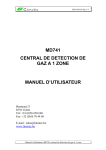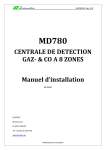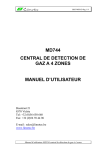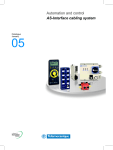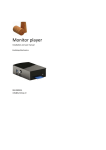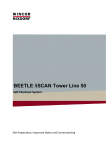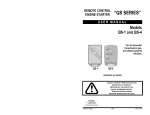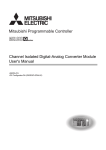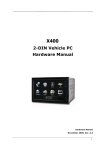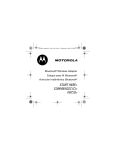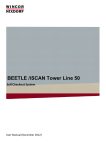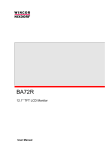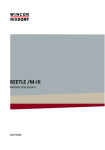Download Operating Manual KD780 Gas and CO detection control
Transcript
Operating Manual KD780 Gas and CO detection control panel 1. Target group The target group of this manual are qualified personnel of the gas safety and regulating technology, skilled personnel or the persons instructed by them. Due to their specialist training, knowledge and experience and knowledge of standard regulations, they are capable of evaluating the work assigned to them and recognising possible dangers. Only they are permitted to carry out assembly, commissioning, settings and maintenance on the devices in compliance with the recognised rules for occupational safety. Hang this instruction manual in a readily visible place inside the installation room! Do not carry out any work until you have read the safety instructions of this instruction manual. 2. Warnings 2.1 General warnings The recognised occupational safety rules and accident prevention regulations must be observed and, if necessary, personal protective measures must be taken. All adjustments and settings should only be performed in accordance with the instruction manuals of the connected machines. Never carry out work as long as gas pressure or voltage is applied. Avoid open fire. Please observe public regulations. Protection from environmental impacts and weather conditions (corrosion, rain, snow, icing, humidity (e.g. by condensation), mould, UV radiation, harmful insects, poisonous, corrosive solutions/liquids (e.g. cutting and cooling fluids )), must be guaranteed. Depending on the installation site, it may be necessary to take protective measures. The device may only be operated in compliance with the operating conditions stated on the type plate. M • Edition 09.14 • Nr. 266304 Prior to assembly, the device must be inspected for transport damage. 1 … 24 The device must not be exposed to open fire. Protection against lightning strikes must be guaranteed. The device must be protected from vibrations and mechanical impact. Explanation of the symbols 1, 2, 3,... = Order of action • = Instruction 2.2 Designated use The device is used in accordance with its designated use if the following instructions are observed: • Use of the device in gas transport and gas distribution networks, commercial and industrial plants. • Use only in compliance with the operating conditions stated on the type plate. • Use in perfect condition only. • Use in pressure regulator stations according to EN 12186 and EN 12279. • Malfunctions and faults must be eliminated immediately. • Use with gases of the 1st and 2nd gas families according to EN 437 only. • Use only in observance of the instructions given in this instruction manual and of national regulations. • Use with dry and clean gases only, no aggressive media. • Operator errors or misuse present risks to life and limb of the operators and also to the device and other material property. • If used in accordance with their designated use, the devices are safe to operate. • Non-observance of the regulations may result in personal injury or material damage, financial damage or environmental damage. M• Edition 09.14 • Nr. 266304 2.3 Risks in case of misuse 2 … 24 M • Edition 09.14 • Nr. 266304 4. Table of contents 3 … 24 1. Target group 1 2. Warnings 1 2.1 General warnings 1 2.2 Designated use 2 2.3 Risks in case of misuse 2 3. Table of Contents 3 4. For your safety 4 5. Installation prescriptions 4 5.1 The gas detector 5 5.1 KD780 Gas- & carbon monoxide detection control panel 4 5.2 The gas detector 5 5.3 The carbon monoxide detector 6 5.3.1 Detection principle of the carbon monoxide detector 6 5.4 The wiring 6 5.5 The connection to the mains 7 6. Start-Up of the KD780 control panel 7 7. Led indicators on the KD780 control panel 8 8. Maintenance instructions 8 8.1 Maintenance instructions gas detector 8 8.1.1 Maintenance of the explosion proof gas detector 8 8.1.2 Maintenance of the non-explosion proof gas detector 8 8.1.3 Maintenance of the sensor 9 8.1.4 Replacement of the gas detector 9 8.1.5 Replacement of the carbon filter 9 8.2 Maintenance instructions carbon monoxide detector 10 8.2.1 Maintenance instructions carbon monoxide detector 10 8.2.2 Replacement of the carbon monoxide detector 10 8.3 Maintenance instructions gas detection control panel 10 8.3.1 Replacement of the batteries 11 9. Additional display functions 11 9.1 Calibration of the touchscreen 11 9.2 Testing relay outputs through simulation of an alarm 12 9.3 Changing the alarm levels of a zone 12 9.4 Reset to factory set-up 13 9.5 Switching off zones by software 13 9.6 Calibration of a zone 13 9.7 Switching on/off the monitoring of the batteries 14 9.8 Detector test 14 10. Outputs15 11. External communication buses 16 11.1 PC-Bus (RS232) 16 11.1.1 Configuration software with licence 16 11.2 i/O-Bus (RS485) 16 11.2.1 Wiring & construction of the RS485-network 16 11.2.1 The external relay printed circuit boards 17 12. Some values and additional information 18 13. Enclosure - factory adjustments 20 13.1 Factory adjustments for gas A2 20 13.2 Factory adjustments for gas A2 + 0/1 21 13.3 Factory adjustments for gas A2 + F 22 13.4 Factory adjustments for carbon monoxide + A1 23 4. For your safety Each use of the DUNGS KD780 gas- and carbon monoxide detection control panel assumes the knowledge and the consideration of this operating manual. Only qualified technicians are authorised to startup, maintain and repair DUNGS KD780 gas- and carbon monoxide detection control panels. An electrical connection with apparatus, which are not mentioned in this operating manual or on the wiring diagrams, can only be achieved after consultation of the technical department of the manufacturer. The responsibility for the correct functioning is handed over to the owner or to the user if the DUNGS KD780 gas- and carbon monoxide detection control panel is started-up, maintained or repaired by an unauthorised technician. DUNGS cannot be held responsible for damage resulting from the nonobservance of the above mentioned instructions. 5. Installation prescriptions 5.1 KD780 Gas- & carbon monoxide detection control panel • • The DUNGS KD780 gas- and carbon monoxide detection control panel must be fixed on a wall free of vibrations via the 4 wall fixing points in the bottom of the housing. The correct functioning of the control panel can be disturbed if the printed circuit boards or the wiring are installed near switching, power transporting conductors (do not incorporate the control panel in a switch-box). The relays for alarm level 1, alarm level 2, alarm level 3 and ON/ OFF (alarm level 4 for carbon monoxide detection) on the KD780 gas- and carbon monoxide detection control panel are fit for the connection of resistive charges. The contact ratings for the maximum resistive charges are 230VAC/2A. the connection of inductive charges is only author- ised with the necessary restrictions. A solid state relay, switching the charge in case of a zero-cross of the 230Vac mains voltage, is used for the connection of valves. The solid state relay switches in case of alarm level 2 (gas detection) or alarm level 1 (carbon monoxide detection), unless otherwise programmed. • An electrical connection with apparatus, which are not mentioned in this operating manual or on the wiring diagrams can only be achieved after consulting the technical department of the manufacturer. • Due to the authorized wiring distances between the control panel and the detectors, it is possible to install the KD780 gasand carbon monoxide detection control panel at any location in the building. The control panel must be installed outside the explosion proof room! • The DUNGS KD780 gas- and carbon monoxide detection control panel is appropriate for the connection of maximum 8 gas detectors. The number of gas- or carbon monoxide detectors connected to one zone is limited to one detector. The MD740 gas detectors and the KD780 carbon monoxide detectors can be combined on the same KD780 gasand carbon monoxide detection control panel. This means that the detection of methane, propane, butane and carbon monoxide is possible with one control panel. The combination of gasand carbon monoxide detectors is only possible by changing the default programming of the control panel, using the KD780 configuration software. • The detection zones, which are actually not used on the KD780 control panel, must be closed off using the enclosed resistors (7 resistors). It is possible to simulate a gas detector by means of a 5K1 (5100 Ohm-1/4Watt) resistor. The resistor is connected between the terminals “+” and “R” of the concerning detection zone. M• Edition 09.14 • Nr. 266304 • 4 … 24 5.2 The Gas Detector • • M • Edition 09.14 • Nr. 266304 • 5 … 24 The gas detectors LIM12A and LIM/ IR-I/M are only appropriate for the detection of methane (natural gas). The LIM12A gas detector is not suitable for use in non-residential and industrial applications. The LIM12A gas detector is equipped with a white label and the letter ‘M’. The LIM/IRI/M is equipped with a label “IR-I”. Methane is lighter than air, consequently the LIM12A and LIM/IR-I/M gas detectors must be fitted on the ceiling. If the ceiling is higher than 3 meters, the gas detector should be installed above the spot of risk. The gas detectors LIM15A and LIM/ IR-I/P are only appropriate for the detection of propane. The LIM15A gas detector is not suitable for use in non-residential and industrial applications. The LIM15A gas detector is equipped with a white label and the letter ‘P’. The LIM/ IR-I/P is equipped with a label “IR-P”. Propane is heavier than air, consequently the LIM15A and LIM/IR-I/P gas detectors must be fitted on the floor. Depending on the application, one or more gas detectors are installed. In case of space or concentration detection, minimum one gas detector per room should be installed (number of detectors is depending on the surface). In case of gas leak detection, one gas detector for each high-risk spot should be installed (e.g. burner, gas pipe, gas meter, …). The gas detectors, which are installed immediately above the high-risk spot, should preferably be equipped with a collector bin with a surface of approximately 1 m² and equipped with edges with a minimum height exceeding the height of the detector housing. Despite the absence of standardisation concerning the protected surface per detector, generally accepted is the installation of 1 detector per 50 m². • The gas detector is available in 2 housings, in particular an explosion proof housing and a non-explosion proof housing: ü The explosion proof gas detector is mounted in a black explosion proof synthetic housing and is ISSeP12ATEX037 CE 0492 II 2 G / EEx d IIB T5 Gb certified. ü The non-explosion proof gas detector is mounted in a grey nylon housing with the same shape as the explosion proof housing. The non-explosion proof housing contains no explosion proof filter near the inlet. • The gas detector is fitted on the ceiling or on the floor (depending on the type of gas) free of vibrations. • The gas detector should not be installed in a continuous airflow. • The gas detector is used on locations with a maximum relative humidity of 95% (without condensation). • The explosion proof gas detector must be equipped with an explosion proof plug. This plug is not included, but separately available. • Always switch off the KD780 control panel before connecting the wiring to the gas detector. • Connect the “+”, “-“ and “R” terminals of the gas detector according to the KD780 wiring diagrams. A faulty connection can damage beyond repair the gas detector. • Furthermore, ensure that: ü The air can circulate freely around the gas detector. ü The gas detector is easily accessible for maintenance or repair. ü The danger for mechanical damage is limited. LIFE (ABERRATION < 5%) : 5 YEAR : Provided ideal environmental parameters. Testing with a lighter damages the gas sensor and consequently limits the ideal life of the sensor! Certain substances, such as sulphur, chorine, phosphorous and silicones can disturb the good functioning of the sensor and sometimes lead to a defective detector! DO NOT TEST WITH A LIGHTER! 5.3 The Carbon Monoxide Detector • The KD780 carbon monoxide detector is appropriate for the detection of the dangerous carbon monoxide gas. This type of gas is produced by a poor combustion of a gas-, coal-, wood- or oil heater or due to the exhaust fumes produced by vehicles in underground car parks. The carbon monoxide detector should be installed on a draft-free location on a height of approximately 1,5 m. • one carbon monoxide detector per room should be installed (number of detectors depending on the surface). In case of leak detection, one carbon monoxide detector for each spot of risk should be installed. The monitored surface covered by one carbon Depending on the application and location, one or more carbon monoxide detectors are installed. In case of space or concentration detection, minimum monoxide detector is approximately 400 m². • The KD780 carbon monoxide detector is mounted in a polypropylene housing. 5.3.1 Detection principle of the carbon monoxide detector The functioning of the KD780 carbon monoxide detector is based on the principle of the electrochemical fuel cell . this detection principle is distinguished from others by: • An important selectivity for carbon monoxide gas, which avoids the use of an active carbon monoxide filter and which does not change the sensitivity trough air pollution. • A small aberration of the sensitivity trough obsolescence. • The insensitivity to other gases, e.g. the simultaneous presence of nitrogen dioxide gas, also produced due to a poor combustion, hardly influences the measuring. • High stability in relation to humidity- and temperature variations. 5.4 The Wiring • The wiring from the DUNGS KD780 gasand carbon monoxide detection control panel to the gas- and carbon monoxide detectors must be executed according to the valid rules and regulations. Pay also attention to the installation prescriptions when the wires traverse explosion proof areas. The section of the wires for the connection of the gas- and carbon monoxide detectors to the control panel must be according the following prescriptions: Up to 500 meters: min. 3x 0,8mm ground potential. In order to avoid contact with the ground, the shield should be cut as close as possible to the outer sheath of the wire in the detector base and, if necessary, isolated with tape. shielded wire. Up to 1 k m: min. 3x 1 mm² shielded wire. More than 1 km: contact DUNGS. • • The wiring of the gas detectors must be physically separated from current carrying conductors and electromagnetic interference sources. The minimum distance, as described in the standard EN50174-2 (typical value 30 centimetres) must be respected. The shield is connected to the ground conductor in the KD780 control panel. Connect the shield only at one side to the • The use of fire-resistant wires is, because of the chance of damage of the gas sensor due to disengaged substances, strongly discouraged. M• Edition 09.14 • Nr. 266304 • 6 … 24 5.5 The connection to the mains • The supply cables must be executed according to the applicable rules and regulations. • Type of cable for the power supply: XVB 3G1,5. • The supply cables is connected to a bipolar fuse of maximum 10A available in the neighbourhood of the gas- and carbon monoxide detection control panel. The fuse and the supply cable are reserved exclusively for the power supply of the DUNGS KD780 control panel. • • Use M20 plugs for entering the supply cable. Before starting any repair or maintenance activities, disconnect this fuse. 6. Start-Up of the KD780 control panel • Mounting of the KD780 control panel and of the gas- and carbon monoxide detectors. • Connection and verification of the wiring according to the wiring diagram: ü 230Vac mains voltage. ü Gas- and carbon monoxide detectors. ü Outputs. M • Edition 09.14 • Nr. 266304 ATTENTION: the gas and carbon monoxide detectors have a universal output signal. As a result of this, the detectors can be exchanged mutually and do not require an adjustment on a fixed zone of the control panel. Only if a carbon monoxide detector is connected to a zone, on which previously a gas detector was connected, the programming of the control panel should be adapted. 7 … 24 • Zones, which are not used, should be closed off by means of the resistors and can be disconnected by software via the display of the control panel. • Check the connections of the gas detector according to the wiring diagrams. A faulty connection can cause a technical failure of the gas- or carbon monoxide detector and the control panel. relay switches at an alarm level 2. Gas detector faults are rearmed automatically. ü CO + A1 Carbon monoxide detection control panel. The solid state relay switches at an alarm level 1. Carbon monoxide detector faults are rearmed automatically. 1. Connect the KD780 control panel to the mains voltage. 2. Select the language on the display. • 3. Next select the type of control panel: ü GAS: A2 + 0/1 Gas detection control panel. The solid state relay switches at an alarm level 2 and when inactivating one or more gas detectors. Gas detector faults are rearmed automatically. ü GAS: A2 +F Gas detection control panel. The solid state relay switches at an alarm level 2 and in case of a gas detector fault. Gas detector faults are not rearmed automatically. ü GAS: A2 Gas detection control panel. The solid state • The KD780 gas and carbon monoxide detection control panel is supplied with the default factory set-up for gas- or carbon monoxide detection. The default factory setup includes the configuration of the alarm levels per detector and the outputs in case of alarm and fault and the profile of the relay contacts and the transistor outputs. It is possible to adjust the factory setup by using the KD780 configuration software. • Each gas- and carbon monoxide detector is calibrated before shipment. It is possible to verify this calibration during the start-up of the control panel. The calibration of the LIM12A gas detector should be done with a +/- 50% LFL mixture of methane (2,5% methane and 97,5% air). The calibration of the LIM15A gas detector is tested with a +/- 50% LFL mixture of propane (1,1% propane and It is possible to program a combination of gas- and carbon monoxide detectors by using the KD780 configuration software. 4. The control panel will ask in batteries are connected to the KD780 control panel. Confirm by making the right choice. 5. Set date and time. • control panel switches automatically on. The green LED “in operation” is illuminated. The gas- and carbon monoxide detection control panel now starts a test routine and activates the warming-up of the sensor. During these 30 seconds, the control panel is disconnected. The display indicates the remaining time of the test routine. After the time delay, the 98,9% air). The carbon monoxide detector can be tested with a carbon monoxide mixture of 200 PPM. The testing of a gas detector with a lighter damages beyond repair the gas sensor! • The outputs can be tested via the menu “The simulation of an alarm on a zone” (see user’s manual § 6.2.4.4). • By means of the KD780 configuration software, the monitoring of the 230Vac • mains voltage and the batteries is switched on or off. It is also possible to switch on or off the monitoring of the batteries via the menu “Technician”. Test the monitoring of the mains voltage by disconnecting the 230Vac (if the control panel is equipped with batteries). The built-in buzzer is activated and on the display appears the announcement “Fault 230V”. been switched into the test position and illuminates continuously if at least 1 zone has been switched off. 7. Led indicators on the KD780 control panel • L1: Green LED “In operation” illuminates continuously as soon as the control panel is switched on. • L3: Red LED “Alarm level 2” illuminates if at least 1 zone has reached an alarm level 2. • L5: Red LED “Alarm level 4” illuminates if at least 1 zone has reached an alarm level 4. • L2: Red LED “Alarm level 1” illuminates if at least 1 zone has reached an alarm level 1. • L4: Red LED “Alarm level 3” illuminates if at least 1 zone has reached an alarm level 3. • L6: Yellow LED “Common fault”. • L7: Yellow LED blinks if at least 1 zone has 8. Maintenance instructions 8.1 Maintenance instructions gas detector 8.1.1 Maintenance of the explosion proof gas detector proof filter. In areas with a higher degree of pollution, this filter can get filthy. The cleaning of this filter can be done by using a liquid that removes fat or with compressed air. Pay attention that the compressed air is used from the inner side of the cover on the filter. The internal active carbon filter must be replaced periodically. 8.1.2 Maintenance of the non-explosion proof gas detector The non-explosion proof housing also consists of 2 parts (base and cover). The housing itself is free of maintenance, but the sensor inside the housing is subject to pollution and the internal active carbon filter must be replaced periodically. Dust and other external pollution that could prevent the penetration of the surrounding air must be removed on a regular base. M• Edition 09.14 • Nr. 266304 The explosion proof housing consists of 2 parts (base and cover). The cover contains an explosion 8 … 24 8.1.3 Maintenance of the sensor The sensor is equipped with a protection. This protection contains very small holes and can be affected by pollution. A pollution of the sensor will cause a decreased sensitivity of the sensor compared to the detected gas. The response time and the sensitivity of the sensor can be tested with a calibrated gas. It is not possible to clean the sensors. The gas detector must be calibrated according to our prescriptions and has a normal lifetime of approximately 5 years (aberration < 5% - see also technical specifications). The detection of high gas concentrations is a destructive process for the built-in gas sensor. Consequently, the calibration of a gas detector after the effective detection of gas is strongly recommended. The recalibration of a LIM12A and LIM15A gas detector can only be performed by the manufacturer of the sensor. 8.1.4 Replacement of the gas detector 1. Switch off the relevant zone by means of the display. 2. Switch off the control panel. 3. Remove the old gas detector and install the new one. 4. Switch on the control panel. 5. Perform a reset of the calibration of this detection zone. This reset can be done by selecting in the menu “Technician” the submenu “Sensor calibration”. Then the relevant zone shall be selected. When pressing on “Reset Cal”, the calibration will return to the default factory set-up. Attention: a reset of the calibration will only be possible if this sensor has experienced in the past a software recalibration on the control panel via the menu “Sensor calibration”. 8.1.5 Replacement of the carbon filter M • Edition 09.14 • Nr. 266304 Each explosion proof and non-explosion proof detector housing contains an active carbon filter. This filter removes a part of the particles having harmful consequences on the correct functioning of the gas 9 … 24 sensor. The active carbon filter absorbs only a limited quantity of the harmful particles. Consequently, the replacement of the filter during the maintenance of the gas detection system is required. • Switch on the relevant zone. • Each gas detector is calibrated before shipment. It is possible to verify this calibration during the start-up of the control panel. The calibration of the LIM12A gas detector should be done with a +/- 50% LFL mixture of methane (2,5% methane and 97,5% air). The calibration of the LIM15A gas detector is tested with a +/- 50% LFL mixture of propane (1,1% propane and 98,9% air). The carbon monoxide detector can be tested with a carbon monoxide mixture of 200 ppm. The testing of a gas detector with a lighter damages beyond repair the gas sensor! 8.2 Maintenance instructions carbon monoxide detector 8.2.1 Maintenance of the carbon monoxide detector The carbon monoxide detector is mounted in a synthetic housing (65x105x55mm). This housing is free of maintenance. Dust and other external pollution that could prevent the penetration of the surrounding air must be removed on a regular base. Considering the character of the installation, it concerns a detection system to guarantee the safety of persons, a yearly testing and maintenance of the installation by a competent technician is strongly recommended. 8.2.2 Replacement of the carbon monoxide detector 1. Switch off the relevant zone by means of the display. 2. Switch off the control panel. 3. Remove the old carbon monoxide detector and install the new one. 4. Switch on the control panel. 5. Perform a reset of the calibration of this detection zone. This reset can be done by selecting in the menu “Technician” the submenu “Sensor calibration”. Then the relevant zone shall be selected. When pressing on “Reset Cal”, the calibration will return to the default factory set-up. Attention: a reset of the calibration will only be possible if this sensor has ex- perienced in the past a software recalibration on the control panel via the menu “Sensor calibration”. • Switch on the relevant zone. • Each carbon monoxide detector is calibrated before shipment. It is possible to verify this calibration during the start-up of the control panel. The calibration of the KD780 carbon monoxide detector should be done with a calibrated gas with a concentration of 200 ppm. 8.3 Maintenance instructions gas detection control panel 1. Verification of the internal supply voltage. 2. Verification of the gas and carbon monoxide detectors with a calibrated gas. 3. Replacement of the active carbon filter. 4. Verification of the respective relay outputs at the differtent alarm levels. 5. Testing of possible valve. 6. Verification of the functions FAULT-ON/OFF. 7. Testing of the optional batteries on their good functioning. M• Edition 09.14 • Nr. 266304 The DUNGS KD780 gasand carbon monoxide detection control panel is constructed with high-quality components that are hardly submitted to obsolescence. The maintenance of the control panel can be limited to the verification of the calibration and the performance of a functional test of the different parts of the control panel: 10 … 24 8.3.1 Replacement of the batteries The batteries of the KD780 gas- and carbon monoxide detection control panel should be replaced if one of the announcements below is indicated on the display: "Fault : Fatal Bat." The batteries are subject to a number of tests by the control panel. The batteries are defective and should be replaced. "Fault : Internal R." The internal resistance of the batteries is monitored by the control panel. This resistor raises due to obsolescence of the batteries. If the control panel detects an inadmissible value, the control panel will generate a fault announcement. The batteries are in a bad condition and should be replaced. 9. Additional display functions 9.1 Calibration of the touchscreen The control panel is equipped with an LCD display with touchscreen for the operation of the system. If the touchscreen does no longer respond correctly, a calibration may be required. Follow the routine listed below in order to calibrate the touchscreen: 1. Switch off the control panel 2. Open jumper JP3 on the motherboard of the control panel. M • Edition 09.14 • Nr. 266304 3. Switch on the control panel. 11 … 24 4. The menu to start the calibration appears on the display. Now, you can close jumper JP3 again. 5. Follow the instructions on the display. The calibration is preferably done by using a stylus or with an object with a rounded tip. • Only when exercising a light push on the LCD display with touchscreen, an operation will only be accepted by the system. • An operation on the touchscreen with a sharp object can damage beyond repair the display! The batteries are tested extensively every 3 hours by means of a battery test. After the replacement of the defective batteries, this battery test should be performed manually: 1. Put the control panel in access level 2. The default pin code is “1234”. 2. Use the navigation buttons to select the software button “Technician”. 3. Press this software button and enter the default technician code “4321”. 4. Press the software button “Battery test”. The batteries are now tested during +/- 1 minute. 9.2 Testing relay outputs through simulation of an alarm Set the control panel in access level 2 in order to simulate an alarm on a zone. Push on the software button “Alarm” in the menu “Zone”. After having pushed on the software button “Alarm”, the zone can be selected on which an alarm level must be simulated. The scroll buttons allow to select a zone. done, the control panel will execute an automatic reset about four minutes after having finished the test. Rearm manually the control panel after having simulated an alarm. If this is not Attention: All outputs will be activated when testing! à Scroll buttons! 9.3 Changing the alarm levels of a zone "Level 1" "Level 2" "Level 3" "Level 4" It is possible to change these alarm levels via the display. The alarm levels for the detection of gas can be adjusted between 10% and 90% LFL and for the detection of carbon monoxide between 50 ppm and 400 ppm. When adjusting the alarm levels, consider that the value for alarm level 1 must be lower than the value for alarm level 2 and so forth. The default setting of the alarm levels is as mentioned below: Gas detection LowerFlammableLimit Carbon monoxide detection PartsPerMillion 20% LFL 100% PPM 40% LFL 200% PPM 10% LFL 30% LFL ROUTINE: 1. Put the control panel in access level 2. The default pin code is “1234”. 2. Use the navigation buttons to select the software button “Technician”. 3. Press this software button and enter the default technician code “4321”. 4. Press the software button “Alarm levels”. 5. Select the zone on which you want to adjust the alarm levels. Use the navigation buttons on the right side to select the different zones. 6. When using the navigation buttons on the left side it is possible 50% PPM 150% PPM to display the different alarm levels. When pushing on the cursor keys on the left or on the right of a level, the values can be adjusted. 7. The “ESC” button allows to return to the main screen. M• Edition 09.14 • Nr. 266304 The KD780 gas- and carbon monoxide detection control panel is equipped with 4 alarm levels. 12 … 24 9.4 Reset to factory set-up The KD780 gas and carbon monoxide detection control panel is supplied with a standard factory set-up. This factory set-up determines the alarm levels per detector, the outputs and the settings of the control panel. It is possible to change the factory setup by means of the KD780 configuration software. If necessary, it is possible to reload the standard factory set-up when following the routine mentioned below: ROUTINE: 1. Put the control panel in access level 2. The default pin code is “1234”. 2. Use the navigation buttons to select the software button “Technician”. relay switches at an alarm level 2 and when inactivating one or more gas detectors. Gas detector faults are rearmed automatically. 3. Press this software button and enter the default technician code “4321”. relay switches at an alarm level 2. Gas detector faults are rearmed automatically. ü CO + A1 Carbon monoxide detection control panel. The solid state relay switches at an alarm level 1. Carbon monoxide detector faults are rearmed automatically. ü GAS: A2 + F Gas detection control panel. The solid state relay switches at an alarm level 2 and in case of a gas detector fault. Gas detector faults are not rearmed automatically. 4. Press the software button “Factory set-up”. 5. Next select the type of control panel you want to use: ü GAS: A2 + 0/1 Gas detection control panel. The solid state ü GAS: A2 Gas detection control panel. The solid state 9.5 Switching off zones by software When switching off a zone by software, the microcontroller of the control panel does not monitor the relevant zone anymore. One or more zones can be switched off by software. Closing off detection zones, which are actually not used on the control panel, using the enclosed resistors remains necessary even if the zone has been switched off by software. ROUTINE: 1. Put the control panel is access level 2. The default pin code is “1234”. 2. Use the navigation buttons to select the software button “Technician”. 3. Press this software button and enter the default technician code “4321”. 4. Press the software button “Zones on/off”. • To the right side of the zone name, there is a button to switch on or off the relevant zone. • When using the navigation button on the right side it is possible to select the other zones. • The “ESC” button allows to return to the main screen. A zone, which has been switched off, is completely deactivated and will consequently no longer produce alarm or fault announcements! M • Edition 09.14 • Nr. 266304 9.6 Calibration of a zone 13 … 24 The KD780 gas- and carbon monoxide detection control panel allows to calibrate a zone. With this function, it is possible to compensate to a limited extend a decreased response of a detector. If case of pollution, the detector does not rise to its maximum value any longer and, as a result of this, not all alarm levels will be reached. The calibration functions only in case of a current consumption between 8,8 mA and 15,2 mA. When the system has been switched in the calibration mode, the control panel will be in the test position. The calibration is done at 50% LFL for gas detectors and at 200 ppm for carbon monoxide detectors. If necessary, the displayed concentration can be adjusted between 30-70% and 120-280ppm. This might be necessary when the testing is done with a calibrated gas slightly deviating from 50% LFL or 200 ppm. It is possible to cancel the calibration by returning to the menu calibration and by pushing on the software button “Reset cal” of the relevant zone. This is required when connecting a new sensor to the zone. ROUTINE: 1. Put the control panel in access level 1. The default pin code is “1234”. 2. Use the navigation buttons to select the software button “Technician”. 3. Press this software button and enter the default technician code “4321”. 4. Press the software button “Sensor calibration”. 5. Select the detector you wish to calibrate by us- ing the cursor keys left and right to the button “Reset cal”. • 6. Test the detector with a calibrated gas (50% LFL or 200 ppm) on the zone you wish to calibrate. If the maximum current consumption is between 8,8 mA and 15,2 mA, it is possible to calibrate this detector by means of the software button “calibration”. • Set the concentration with which the detector has been tested and confirm by pressing on the button “OK”. 7. The “ESC” button allows to return to the main screen. 9.7 Switching on/off the monitoring of the batteries The monitoring of the batteries must be switched off if there are no batteries connected to the control panel. This can be done via the display of the control panel or by using the KD780 configuration software. ROUTINE: 1. Put the control panel in access level 2. The default pin code is “1234”. 3. Press this software button and enter the default technician code “4321”. 2. Use the navigation buttons to select the software button “Technician”. 4. By using the software button “monitoring batteries”, it is possible to switch on or off the monitoring of the batteries. tor. This routine allows to test each detector, one by one, before returning to the control panel for verification. The display is used for putting the different zones into the test mode. No relay contacts will be switched in case of an alarm or a detector fault during the test. The condition of the zones however will be announced on the display. • Once the selected zones are in the test mode, you can start the testing. • After having tested all the detector, the measured concentrations can be checked by navigating between the different zones. • After having finished the testing, the relevant zones must leave the test mode. A detector, which is still in alarm at the moment that the zone is leaving the test mode, will stay in test until the alarm on the detector has disappeared. During the start-up of the gas- and carbon monoxide control panel, it is possible to check the calibration of the gas detectors. In this case you might have the following practical problem: if the gas detector you want to test is outside the room in which the KD780 control panel is installed, you cannot see the maximum deviation of the sensor during the test. When returning to the control panel after having tested the gas detector, the actual condition of the sensor will be displayed. Due to the natural air ventilation near the detector, the actual value will be lower than the maximum value during the test. In order to solve this practical problem, the KD780 control panel can be switched into the position “detector test”. During the detector test, the control panel will memorise the highest measured value of each gas detec- ROUTINE: 1. Put the control panel in access level 2. The default pin code is “1234”. 2. Press the software button “Zones”. 3. Press the software button “Zone test”. • Now you have the choice to put all zones at once in or out of test or to put certain zones in the test mode. M• Edition 09.14 • Nr. 266304 9.8 Detector test 14 … 24 10. Outputs The KD780 gas- and carbon monoxide control panel is equipped with 6 relay contacts, 2 transistor outputs (or open collector outputs) and 1 solid state relay. It is still possible to extend the number of relay outputs by connecting an external relay printed circuit board trough the RS485 bus. The description of the relay contacts and the transistor outputs mentioned below is based on the default settings of the system. By using the KD780 configuration software, it is possible to adapt the programming as you wish. 4 double voltage free changeover contacts max 230Vac/2A resistive or 80W magnet valve: ü Relay 1 : Alarm level 1. ü Relay 2 : Alarm level 2 ü Relay 3 : Alarm level 3. ü Relay 4 : ON/OFF-relay in case of gas detection – Alarm level 4 in case of carbon monoxide dete tion. • 2 single voltage free changeover contacts 30Vdc/1A. ü Relay 5 : Common fault. ü Relay 6 : Buzzer. • TRANSISTOR OUTPUTS: M • Edition 09.14 • Nr. 266304 • 1 Solid state relay for the activation of a magnet valve max. 1A Common fault: This function is activated in case of any fault announcement from a zone or in case of a power supply failure. A fault announcement from a detector is caused by an interruption or a short-circuit in the de- position, the tension on this terminal is “high impedance” (= no positive ; no 0V signal) and becomes 0Vdc if the output is activated. This output can be connected with the coil of an external relay, of which the other side is firmly connected with the positive. As soon as the transistor output is activated, the external relay contact will switch on. A fly-back diode is installed on the coil of the external relay. On/Off: This function is activated as soon as a zone of the KD780 gas- and carbon monoxide control panel is switched off. This function is automatically rearmed as soon as all zones of the control panel are switched on again. Buzzer: The internal buzzer of the KD780 gas- and carbon monoxide control panel is switched on at each alarmand fault announcement and is switched off after the actuation of the software button “alarm silence”. The relay contact “buzzer” follows the functioning of the internal buzzer and can be used to activate an external sounder or flash. The levels 1, 2 and 3 of a carbon monoxide control panel are interpreted as a pre-alarm. Consequently, the internal buzzer and the common alarm relay of a carbon monoxide control panel are only activated when reaching alarm level 4. However, this is adjustable by means of the KD780 configuration software. RELAY CONTACTS FOR GAS DETECTION: 15 … 24 tector wiring or in case of an electronic failure of the gas detector. Remark: Not all electronic failures are effectively announced as a failure. • Max. 80mA resistive (ohmic charge). • Max. 50mA inductive (coils). • Transistor outputs or open collector outputs are available by means of one connection terminal. In the quiescent • A fly-back diode is a diode of which the anode is connected to the 0V of the relay coil and the cathode to the positive of the relay coil. A profile is set-up for each relay output or transistor output. The profile determines the behaviour of the output in case that the event, linked to this output, is announced on the control panel. • Deactivated with silence: the selected outputs return to the quiescent position after the actuation of the software button “alarm silence”. The other outputs return to the quiescent position after the actuation of the software button “system reset”. • Fail-safe: a fail-safe relay switches according to a negative logic. In the quiescent condition, the coil of a fail-safe relay is permanently charged, so that the contact is switched on. The charge on the coil of a fail-safe relay drops as soon as the event, linked to this relay, is announced on the control panel. Attention, the contacts of a fail-safe relay are always mentioned on the wiring diagrams assuming that the coil is voltage-free. • Latch: a latched relay switches on as soon as the event, linked on the system to this relay, is active and switches off after the actuation of the software buttons “system reset” or “alarm silence”. A non-latched relay follows the event to which it has been linked. The relay switches on as soon as the event is active on the control panel and returns automatically into the quiescent position when the conditions for the announcement of the event are not fulfilled anymore. The corresponding LEDindicators on the front of the control panel are rearmed. Non-latched relays are interpreted by the control panel as a pre-alarm. Consequently, the internal buzzer and the common alarm relay are not activated. However, this is adjustable by means of the KD780 configuration software. 11. External communication buses 11.1 PC-Bus (RS232) The DUNGS KD780 gasand carbon monoxide control panel is equipped with a RS232 output for the connection of a computer to the control panel by means of a standard serial wire. As soon as the KD780 configuration software is initiated, the correct serial port is selected and the connection will be active. 11.1.1 Configuration software with licence The KD780 configuration software requires a licence. Attention: The KD780 configuration software with licence is only available for authorised customers of the KD780 detection system. Moreover, the KD780 configuration software will only be available after having followed a training concerning the wiring, the connections, the programming and the servicing of the KD780 detection system. 11.2 I/O-Bus (RS485) M• Edition 09.14 • Nr. 266304 The I/O-bus is an external bus containing all peripheral modules. The construction of the I/O-bus is according to the RS485network. It is possible to depart from CON2 on the mother board by means of an UTP-cable, but the RS485 I/O-bus is also available by means of the terminal block. 16 … 24 11.2.1 Wiring & construction of the RS485-network The I/O-bus corresponds to the convention of a RS485-network. The points mentioned below must be followed strictly for the construction of the I/O-bus. M • Edition 09.14 • Nr. 266304 • 17 … 24 • Maximum length: the RS485 technology specifies a maximum length of 800 meters. • Loop wiring: wire the periphery always in loop. Wiring in star is not allowed! Control panel RxTx Relay PCB 1 TxRx Relay PCB 2 TxRx Loop wiring RIGHT Control panel RxTx Relay PCB 1 TxRx Relay PCB 2 TxRx Loop wiring WRONG Cable: 2 x twisted pairs cable for the RS485 connection. 2x 1,5mm² for the power supply of the relay printed circuit board (depending on the length of the cable of on the number of sounders). Remark: A shielded cable is recommended in industrial environments. The wiring must be physically separated from current carrying conductors and electromagnetic fields. The minimum distance, as described in the standard EN50174- 2 (typical value 30 centimeters), must be respected. • Closing the network: Peripheral modules are equipped with 2 jumpers to close off the « Tx » (Transmit) and the « Rx » (Receive) of the communication bus. Closing off the communication bus is no need, but can provide a solution in case of problems caused by external disturbances. Only the last module on the I/O-bus should be closed. These jumpers are mentioned on the wiring diagrams. 11.2.2 The external relay printed circuit boards The KD780 gas- and carbon monoxide control panel is equipped with 6 relays contacts and with one solid state relay. It is possible to extend the control panel, by means of the I/O-bus, with one or more external relay printed circuit boards. The addressing of the relay printed circuit boards is done hexadecimal by means of a HEX- switch. A unique address, within the range of 1 to 8, is assigned to each printed circuit board. A relay printed circuit board T240018 is equipped with 16 relay contacts. The first 2 relay contacts serve as monitored outputs. Relay 16 on the first printed circuit board (address 1) is always a fail-safe relay. An additional external power supply will be required depending on the number of relay printed circuit boards and depending on the number of sounders connected. Attention: The monitoring of the monitored outputs on the relay printed circuit board is always active. It is not possible to switch on or off the monitoring through the parameters. Place always the end-of-line resistor on the monitored outputs which are not used in order to avoid fault error messages. 12. Some values and additional information Tension after power supply : +/- 27,6VDC • Battery load tension (not loaded) : +/27VDC • Current values in milliampere in the detector circuit. These current values are measured with a calibrated and accurate measuring apparatus, connected in series with the return line of the gas or carbon monoxide detector. Voltage (DC) measured between the “-” and the “R” connection of the detector (+/-10%). Value in case of a carbon monoxide detector Value in case of a gas detector Value measured in milli-ampere Open circuit Open circuit 2 40PPm 10%LFL 4,64 1,1 120PPM 30%LFL 8,8 1,9 0PPM 80PPM 160PPM 200PPM 400PPM Short circuit • An incorrect connection can damage beyond repair the gas or carbon monoxide detector. Check the connections of the detector before connecting the KD780 gas- and carbon monoxide control panel to the mains voltage. Use for this purpose an universal multi-meter on the position ‘diode’ 0%LFL 20%LFL 4 7,2 40%LFL 10,4 100%LFL 20 50%LFL Short circuit and follow the routine mentioned below: ü See that the red measuring pin is connected to the positive of the measuring apparatus. ü See that the black measuring pin is connected to the negative of the measuring apparatus. 12 22 Lower than 0,4 1 1,6 2,2 2,5 4,1 4,9 and higher ü Switch the measuring apparatus into the position ‘diode’. ü The drawing listed below gives a survey of the different measurements that can be executed on the detector wiring: M• Edition 09.14 • Nr. 266304 • 18 … 24 1,22 RedBlack 1,9 RedBlack 1,75 RedBlack + • Remark: The values above mentioned are purely indicative and can differ depending on the type of wire used, the length of the wire and the type of multi-meter. M • Edition 09.14 • Nr. 266304 Resistor value in K Ω 2k2 3k3 4k7 5k6 6k8 8k2 10k 15k 19 … 24 R • A gas detector or a carbon monoxide detector can be simulated by using a resistor of 5K1 (5100 Ohm-1/4Watt). The resistor is connected between the “+” and the “R” terminals LFL-percentage 70 49 37 32 27 24 21 16 - of the zone. When connecting in parallel a third resistor on the “+” and the “R” terminals, it will be possible to bring the zone to a certain LFL-percentage. The LFL-percentage is determined depending on the resistor connected in parallel. A survey of a number of typical values is listed below: 13. Enclosure - Factory adjustments 13.1 Factory adjustments for Gas A2 Zones in operation: All zones are in operation. Alarm levels: "Level 1" LowerFlammableLimit 10% LFL "Level 2" 20% LFL "Level 3" 30% LFL "Level 4" 40% LFL Outputs: (Identical outputs from zone 1 to zone 8) 1 2 Relay 3 4 5 6 Solid state 7 Open Collectors 1 2 Fault: Alarm 1: Alarm 2: Alarm 3: Alarm 4: Common outputs: monitoring 230V monitoring batteries (Only if batteries are connected) Relay Solid state Open Collectors 1 2 3 4 5 6 7 1 2 Common fault: Monitoring: Common alarm: On/Off: Fault power supply: Reset: Emergency stop: Deactivated with silence: Fail-safe: 1 2 Relay 3 4 5 6 Solid state 7 Latch: Delay time : The outputs are programmed without delays. Open Collectors 1 2 M• Edition 09.14 • Nr. 266304 Output profiles: 20 … 24 13.2 Factory adjustments for Gas A2 + 0/1 Zones in operation: All zones are in operation. Alarm levels: "Level 1" LowerFlammableLimit 10% LFL "Level 2" 20% LFL "Level 3" 30% LFL "Level 4" 40% LFL Outputs: (Identical outputs from zone 1 to zone 8) 1 2 Relay 3 4 5 6 Solid state 7 Open Collectors 1 2 Fault: Alarm 1: Alarm 2: Alarm 3: Alarm 4: Common outputs: monitoring 230V monitoring batteries (Only if batteries are connected) Relay Solid state Open Collectors 1 2 3 4 5 6 7 1 2 Common fault: Monitoring: Common alarm: On/Off: Fault power supply: Reset: Emergency stop: M • Edition 09.14 • Nr. 266304 Output profiles: 21 … 24 Deactivated with silence: Fail-safe: 1 2 Relay 3 4 5 6 Solid state 7 Latch: Delay time : The outputs are programmed without delays. Open Collectors 1 2 13.3 Factory adjustments for Gas A2 + F Zones in operation: All zones are in operation. Alarm levels: "Level 1" LowerFlammableLimit 10% LFL "Level 2" 20% LFL "Level 3" 30% LFL "Level 4" 40% LFL Outputs: (Identical outputs from zone 1 to zone 8) 1 2 Relay 3 4 5 6 Solid state 7 Open Collectors 1 2 Fault: Alarm 1: Alarm 2: Alarm 3: Alarm 4: Common outputs: monitoring 230V monitoring batteries (Only if batteries are connected) Relay Solid state Open Collectors 1 2 3 4 5 6 7 1 2 Common fault: Monitoring: Common alarm: On/Off: Fault power supply: Reset: Emergency stop: Deactivated with silence: Fail-safe: 1 2 Relay 3 4 5 6 Solid state 7 Latch: Delay time : The outputs are programmed without delays. Open Collectors 1 2 M• Edition 09.14 • Nr. 266304 Output profiles: 22 … 24 13.4 Factory adjustments for carbon monoxide + A1 Zones in operation: All zones are in operation. Alarm levels: CO-detection Part Per Million "Level 1" 50% PPM "Level 2" 1000% PPM "Level 4" 200% PPM "Level 3" 150% PPM Outputs: (Identical outputs from zone 1 to zone 8) 1 2 Relay 3 4 5 6 Solid state 7 Open Collectors 1 2 Fault: Alarm 1: Alarm 2: Alarm 3: Alarm 4: Common outputs: monitoring 230V monitoring batteries (Only if batteries are connected) Relay Solid state Open Collectors 1 2 3 4 5 6 7 1 2 Common fault: Monitoring: Common alarm: On/Off: Fault power supply: Reset: Emergency stop: M • Edition 09.14 • Nr. 266304 Output profiles: 23 … 24 Deactivated with silence: Fail-safe: 1 2 Relay 3 4 5 6 Solid state 7 Latch: Delay time : The outputs are programmed without delays. Open Collectors 1 2 M• Edition 09.14 • Nr. 266304 Postal address: Karl Dungs B.V. 1221 JV Hilversum The Netherlands E-mail [email protected] Internet http://www.dungs.com 24 … 24
























